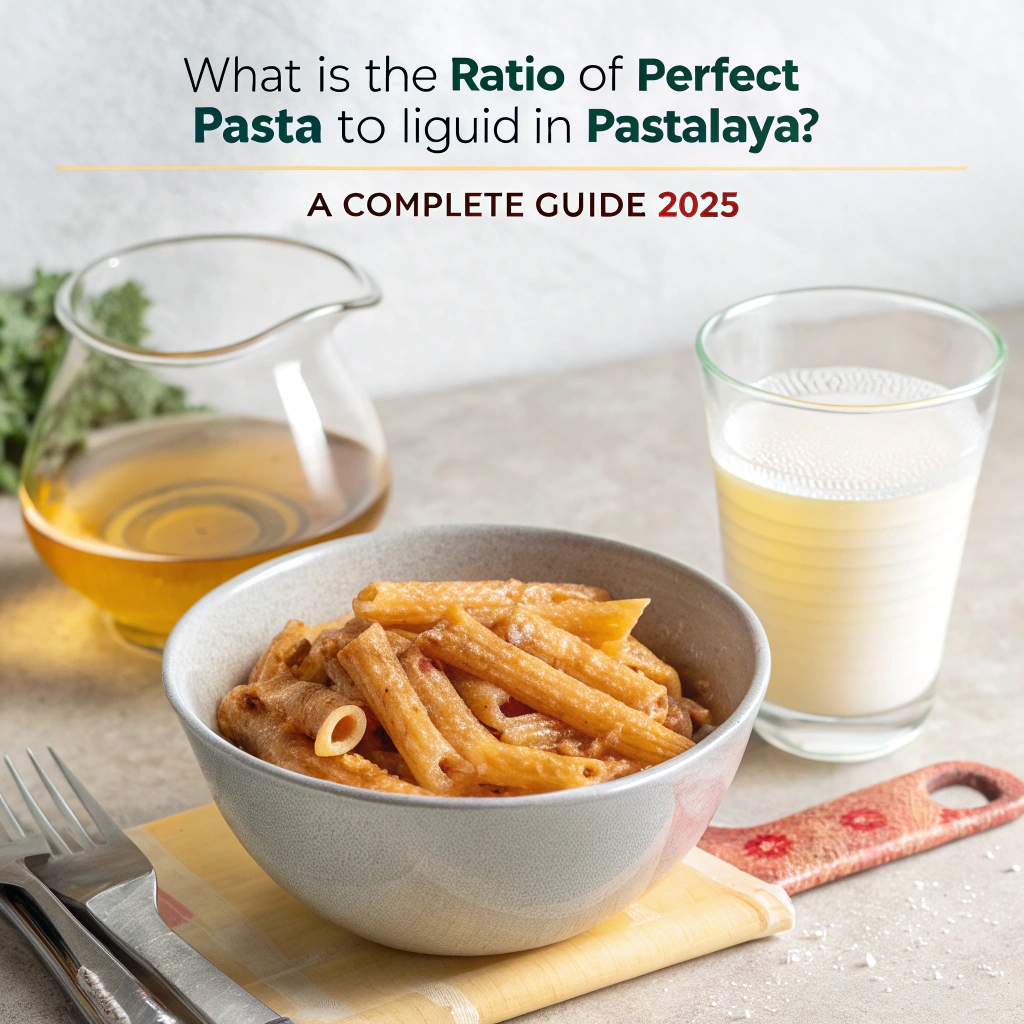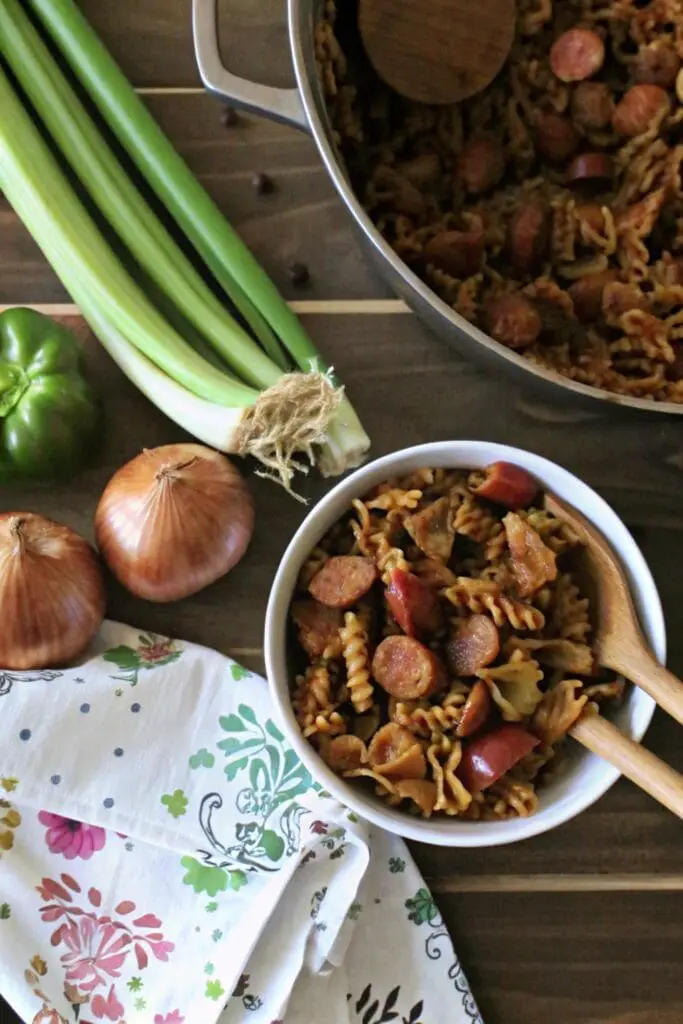Standing in your kitchen, ingredients spread across the counter, you’re about to embark on a culinary adventure that brings together the soul-warming comfort of Cajun cuisine with the beloved simplicity of pasta. Your mind wanders to that incredible pastalaya you tasted at your friend’s gathering last month, and you’re determined to recreate that magic. But then comes the crucial question: exactly Perfect pasta to liquid ratio in pastalaya
Getting this ratio right isn’t just about following a recipe – it’s about understanding the science behind perfect pastalaya. Whether you’re a home cook looking to impress your family or an aspiring chef aiming to master Cajun-Italian fusion, mastering the pasta-to-liquid ratio will transform your pastalaya from good to extraordinary.
Table of Contents
Understanding Pastalaya Basics
Before diving into specific measurements, let’s explore what makes pastalaya unique. This clever fusion dish emerged from Louisiana’s rich culinary landscape, where creative cooks combined traditional jambalaya ingredients with pasta instead of rice. The result? A dish that marries the bold, spicy flavors of Cajun cuisine with the satisfying texture of perfectly cooked pasta.
The magic lies in how pasta interacts with liquid during cooking. Unlike rice, which tends to absorb liquid uniformly, pasta’s absorption rate varies based on its shape, thickness, and composition. Understanding these nuances helps you achieve that ideal consistency where each piece of pasta is tender yet maintains its structure, coated in a flavorful sauce that’s neither too soupy nor too dry.

The perfect Pasta-to-Liquid Ratio
Standard Ratio Guidelines
The foundation of excellent pastalaya starts with mastering the basic ratio: for every pound of pasta, you’ll typically need 4-5 cups of liquid. However, this isn’t a one-size-fits-all solution. Your choice of pasta dramatically influences the precise amount of liquid required.
For short pasta varieties like penne or rotini, stick closer to 4 cups of liquid per pound. These shapes have more surface area and tend to cook more uniformly. When working with long pasta such as spaghetti or linguine, increase the liquid to 4.5 cups. The extra half cup ensures even cooking throughout the length of the pasta. For particularly thick varieties, you might need up to 5 cups of liquid to achieve the perfect texture.
Factors Affecting the Ratio
Your perfect pasta choice isn’t the only variable to consider. In fact, several other factors play crucial roles in determining the ideal liquid amount:
First of all, cooking vessel dimensions significantly affect evaporation rates – consequently, wider pots may require slightly more liquid due to increased surface area. Moreover, the pot’s material and thickness influence heat distribution and retention, which ultimately impacts how quickly liquid reduces during cooking.
Additionally, environmental conditions play a vital role. For instance, cooking in a humid kitchen might require less liquid than in a dry climate, primarily because pasta absorbs moisture from the air. Furthermore, even your altitude can affect cooking times and liquid requirements – specifically, higher elevations typically demand longer cooking times and, as a result, potentially more liquid.
Essential Pastalaya Recipe
Let’s put theory into practice with a foolproof recipe that serves as your foundation for perfect pastalaya every time.
Ingredients Table
| Ingredient | Amount | Notes |
|---|---|---|
| Pasta | 1 pound | Penne or rotini recommended |
| Chicken broth | 4 cups | Low sodium preferred |
| Andouille sausage | 1 pound | Sliced into rounds |
| Chicken | 1 pound | Cubed |
| Bell peppers | 2 medium | Diced |
| Onion | 1 large | Finely chopped |
| Celery | 2 stalks | Diced |
| Cajun seasoning | 2 tablespoons | Adjust to taste |
| Garlic | 4 cloves | Minced |
| Bay leaves | 2 whole | Remove before serving |
| Olive oil | 2 tablespoons | For sautéing |
Step-by-Step Process
- Prepare Your Base:
- Brown andouille sausage until well-caramelized
- Remove and set aside, preserving the flavorful oils
- Season and cook chicken until golden
- Build Your Flavor Foundation:
- Sauté trinity (onions, celery, peppers) until translucent
- Add garlic until fragrant
- Return meats to pot
- The Crucial Liquid Addition:
- Add pasta to the pot
- Pour in measured broth (4 cups for short pasta)
- Add seasonings and bay leaves
- The Cooking Process:
- Bring to initial boil
- Reduce to steady simmer
- Cover and cook 12-15 minutes, stirring occasionally
Troubleshooting Pastalaya Liquid Ratio Problems
Even experienced cooks encounter challenges when making pastalaya. Here’s how to address the most common problems:
How to Fix Incorrect Pasta to Liquid Ratios
If your pastalaya seems soupy:
- Remove lid and cook 2-3 minutes longer
- Stir gently to help pasta release more starch
- Add a handful of freshly grated Parmesan cheese to thicken
- Let rest for 5-7 minutes before serving
Too Dry
When your pastalaya needs more moisture:
- Add hot broth in ¼ cup increments
- Stir gently after each addition
- Allow 2-3 minutes between additions
- Consider adding a touch of cream for richness
Uneven Cooking
To prevent some pasta from being overcooked while other pieces remain firm:
- Ensure even heat distribution
- Stir from bottom up every 3-4 minutes
- Rotate pot position if needed
- Use proper pot size for your portion
Pro Tips for Perfect Pastalaya Liquid Balance
Expert Techniques for Pastalaya Liquid Measurements
The secret to restaurant-quality pastalaya lies in building flavors:
- Start with high-quality andouille sausage
- Use homemade stock when possible
- Toast spices before adding liquid
- Layer seasonings throughout cooking
Timing Considerations
Perfect timing creates perfect texture:
- Monitor pasta at 10-minute mark
- Check consistency every 2 minutes after
- Remove from heat when pasta is slightly firmer than desired
- Allow for residual cooking during rest period
Storage and Reheating
Preserve your pastalaya’s quality:
- Cool completely before refrigerating
- Store in airtight container up to 3 days
- Reheat with added broth or cream
- Stir gently while reheating

Frequently Asked Questions
What is the ratio of Perfect pasta to liquid in pastalaya for feeding a crowd? Primarily, for larger portions, maintain the same ratio but scale up proportionally. Therefore, for every 2 pounds of pasta, use 8-10 cups of liquid, subsequently adjusting based on pasta type and cooking conditions.
Can I adjust the pasta to liquid ratio in pastalaya if I’m using different types of pasta? Indeed, different pasta shapes require slight adjustments. Specifically, thicker pasta needs more liquid, while conversely, thinner varieties require less. Consequently, start with the basic ratio and then adjust based on observation.
How does the pasta to liquid ratio in pastalaya differ from regular pasta dishes? In contrast to traditional pasta cooking, pastalaya requires less liquid because you’re creating a one-pot dish. As a result, the pasta cooks directly in the sauce, thus absorbing flavors while simultaneously releasing starches for creaminess.
Should I add more liquid to my pastalaya if I’m cooking it covered? Generally speaking, use slightly less liquid when cooking covered, primarily because less evaporation occurs. Additionally, start with about ½ cup less than the standard ratio and subsequently adjust as needed.
What’s the best way to fix pastalaya if the pasta to liquid ratio is off? First of all, for too much liquid, continue cooking uncovered. Alternatively, for too little, gradually add hot broth or stock. Furthermore, always adjust in small increments and thereafter allow time for the pasta to respond.
More Ideas
Rotisserie Chicken Meets Creamy Classics
- Crab Brûlée Recipe
For a bold and creamy dish, try a decadent twist with this Crab Brûlée recipe. While traditionally made with crab, this technique can inspire a creamy chicken version. - What Is Creme Brûlée Mostly Made Of?
If you’re interested in creating a rich, dessert-inspired chicken dish, understanding What is Creme Brûlée mostly made of might help you refine the perfect pairing with creamy chicken recipes.
Creative Chicken Salads and Side Dishes
- Chicken Salad Chick Recipes
For a new take on creamy chicken salads, explore What Is Chicken Salad Chick Made Of and add unique textures and flavors to your salad game. - Broccoli Salad as a Side
Add a healthy side dish with this Chicken Salad Chick Broccoli Salad Recipe that pairs beautifully with your rotisserie chicken recipes. - What Makes Chicken Salad Chick So Good?
Learn What Makes Chicken Salad Chick So Good and apply similar techniques to elevate your rotisserie chicken salads.
Elevate Your Baking Game with Rotisserie Chicken Pairings
- Baking with Almond Flour
Consider pairing your chicken meals with baked goods! Learn the secrets of Baking with Almond Flour for gluten-free, flavorful sides. - Secret to Super Moist Cake
Round off your chicken dinner with a dessert by mastering the Secret to Super Moist Cake. Complement savory dishes with a perfect sweet finish. - What Flavor Goes Well with Almond Cake
Want a unique pairing? Discover What Flavor Goes Well with Almond Cake and surprise your guests with an unexpected combination.
Conclusion
Mastering the pasta-to-liquid ratio in pastalaya comes with practice and attention to detail. Remember these key points:
- Start with the basic ratio: 4-5 cups liquid per pound of pasta
- Adjust based on pasta type and cooking conditions
- Pay attention to your ingredients’ moisture content
- Trust your instincts and observations
The beauty of pastalaya lies in its adaptability. As you become more comfortable with the basic ratio, you’ll develop an intuition for adjustments that match your preferences. Each pot of pastalaya teaches you something new about the perfect balance of pasta and liquid.
